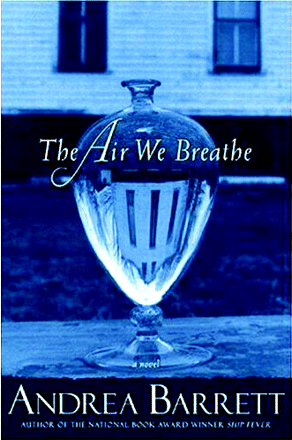Tuberculosis as Narrative
- P.K. Rangachari, MBBS, PhD, Professor (Emeritus) of Medicine

The Air We Breathe. Andrea Barrett. New York: W.W. Norton; 2007. 320 pages. $19.95. ISBN: 0393061086
July 1916. Europe is at war—a new kind of war, where gas attacks have added another twist to man’s capacity to harm himself. Soldiers die choking and gasping for air. For patients at the Tamarack State Sanatorium for the Treatment of Tuberculosis, set in the Adirondacks, the war seems far away. Yet even at Tamarack, the patients find themselves gasping for air. And coughing out blood. And falling into a web of intrigue.
Other novels have been set in a TB sanatorium, the most celebrated being Thomas Mann’s The Magic Mountain. Like Mann, Andrea Barrett brings to life the claustrophobic nature of sanatorium life. But she also deals with science and scientists—and in a more intelligent fashion than many contemporary novelists. She weaves in references to Rutherford, Bohr, Moseley, and Einstein, and she conveys the overwhelming sense of curiosity and wonder that can drive many scientists. Her clinical observations of tuberculosis are also apt.
Barrett also draws interesting parallels between the human pursuit of meaning as it is questionably practiced in war and as it presents itself among the inmates of the sanatorium. For these patients, the enemy is microscopic, but no less insidious than the gaseous poisons that terrorized soldiers at the war front. And the invisibility of the microscopic enemy resonates with the seemingly unknown forces that drive suspicion, enmity, and combat.
In the absence of a cure, the tubercular patients who populate Barrett’s novel must submit to endless rules and constant vigilance, all the while maintaining their own determination to survive. The inmates of the sanatorium, many of whom are immigrants from the very lands where that other war is being fought, are constantly reminded of their good fortune to be at the sanatorium. Like good soldiers, their conscientious obedience to rules signifies their value to the community. And like soldiers, the patients of the State Sanatorium are subject to inequities of privilege and power.
Several miles away from the sanatorium, in the Village of Tamarack Lake, far wealthier patients, living in much greater comfort in private cure cottages, are treated by the same physicians. The two worlds, of privilege and subsistence, intersect when cement factory owner Miles Fairchild, one of the wealthier patients, begins an educational experiment. He invites male patients who are competent in written and spoken English at the State Sanatorium to join a group discussion to share work experiences and knowledge. The group sessions begin smoothly, with Miles lecturing about his passion for fossils and the details of fossil-gathering expeditions in western Canada. Soon, however, the patients of the sanatorium tire of Miles’s orations and take over the discussion, sharing their own experiences. Women join in, and the discussions move onto widely different issues. Celia, one of the participants, tries to explain what Chekov’s stories mean to her: “A Russian writer very—famous there although not here.” She goes on to tell the inmates that Chekov too suffered from tuberculosis; she fore-bodingly explains how very difficult it is for her to summarize the Chekov stories she had treasured. “Summary ruined everything; beauty lay in the story itself, the particular arrangement of sentences.” Gradually, the inmates find they have much in common with each other and take center stage, and Miles becomes marginalized.

Misunderstanding and passions begin to abound, and ill will, like contagion, fills the air. Miles has developed an unhealthy obsession with Naomi, but she, in turn, yearns only for Leo, a Russian-born chemist and one of the indigent patients at the sanatorium. Leo had escaped the dangers of the old world only to find hardship in the new world. When he began to cough up blood, he was promptly reported to the health authorities, lost his job, and landed in the State Sanitorium.

Leo welcomes opportunities provided by the weekly meetings to engage in intellectual discussion. But he remains totally unaware of Naomi’s interest in him, and rather has eyes for Eudora, a ward maid. The complex series of misunderstandings among the four love-struck characters is fueled by a heady mix of paranoia, and innocent gestures prove deadly. When one of his proteges loses his life in a gas attack while fighting with the Canadian forces in France, Miles becomes bitter and resentful of the Sanatorium inmates who come from “those” lands. Miles drums up support for the mounting war and ignites xenophobic sentiments.
The atmosphere of paranoia impinges directly upon the scientific themes that Barrett inserts into her story. Eudora, the science-minded ward maid, finds the X-ray lab fascinating and is encouraged by radiologist Irene Piasecka to pursue this interest. Although Eudora knows little physics or chemistry, she learns by doing, handling Crookes tubes and playing around with exposure times. Eudora is grateful for Irene’s generosity and encouragement. Irene also senses Leo’s longing for intellectual stimulation, and she supplies him with books. Unfortunately, Irene’s kindness to Leo–and more specifically, the fact that both come from immigrant families—creates intrigue and sparks xenophobic passions. When Leo is found with a copy of Mendeleev’s Principles of Chemistry, Miles alleges a foreigner-conspiring plot against American war interests. Miles’s xenophobic paranoia is fostered by jealousy over the attentions Leo receives from Eudora. Eudora has to remind Miles that merely studying chemistry does not make someone a criminal!
By the end of the novel, Leo’s whereabouts are left unclear, although a vague hint is suggested that he has begun his own laboratory to work with grapes and the chemistry of fermentation. In her earlier books, for which The Air We Breathe functions as a prequel, Barrett had given us a glimpse into the lives of Leo’s granddaughters. The Marburg sisters are featured in two short story collections—Ship Fever (which received the National Book Award) and Servants of the Map (a finalist for the Pulitzer Prize).
Andrea Barrett is a writer of great subtlety and depth. Her stories show her deep interest in science and history. Rarely are science and scientists portrayed so well in modern fiction. In The Air We Breathe, the narrative is told by the inmates of the State Sanatorium, who try to make sense of the events that unfold around them. Towards the end, they reflect wryly about how innocent everything seemed at the start, when they had gathered “to learn about fossils, poison gas, the communal settlement at Ovid, about Stravinsky and Chekov, trade unions and moving pictures and the relative nature of time.”
The Air We Breathe is suffused with a gentle, melancholic glow. Barrett’s use of the Great War as a backdrop to the drama that unfolds at the State Sanatorium is poignant. Dreams and desires—and even one’s healthy interest in pursuing knowledge—will weaken and become perverse, when misunderstanding, anger, envy, and fear are allowed to take hold.
- Copyright © 2010



